traction control Citroen C1 2016 1.G Owner's Manual
[x] Cancel search | Manufacturer: CITROEN, Model Year: 2016, Model line: C1, Model: Citroen C1 2016 1.GPages: 269, PDF Size: 7.63 MB
Page 19 of 269
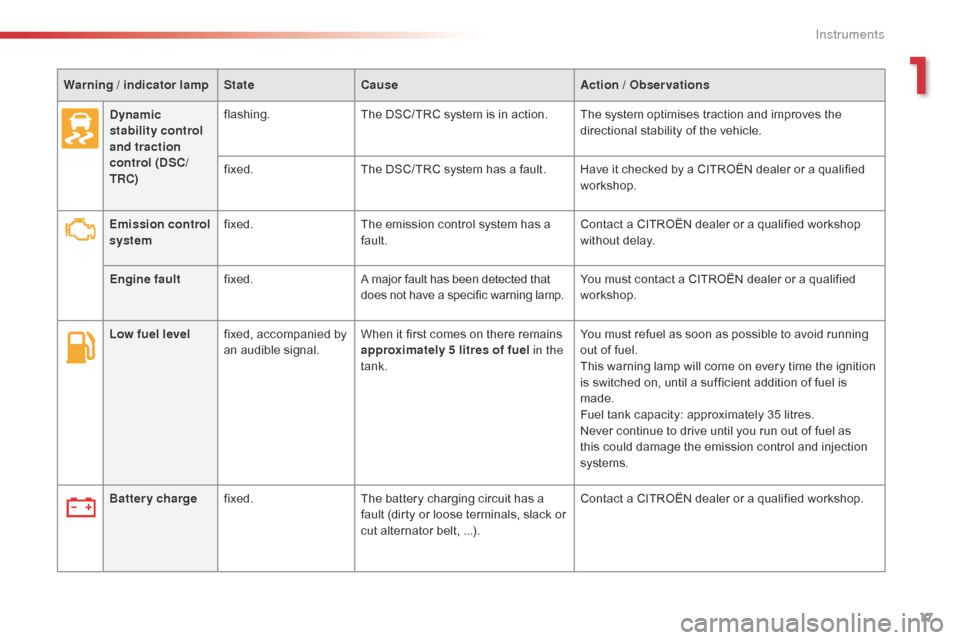
17
C1_en_Chap01_instrument- de-bord_ed01-2016
Low fuel levelfixed,  accompanied  by  a
n  audible  signal.When
 it  first  comes  on  there  remains  a
pproximately 5 litres of fuel in the
tank. You
 must  refuel  as  soon  as  possible  to  avoid  running  o
ut  of  fuel.
This
 warning  lamp  will  come  on  every  time  the  ignition Â
i
s  switched  on,  until  a  sufficient  addition  of  fuel  is Â
m
ade.
Fuel
 tank  capacity:  approximately  35  litres.
Never
 continue  to  drive  until  you  run  out  of  fuel  as Â
t
his  could  damage  the  emission  control  and  injection Â
s
ystems.
Battery charge fixed. The
 battery  charging  circuit  has  a Â
f
ault  (dirty  or  loose  terminals,  slack  or Â
c
ut  alternator  belt,  ...).Contact
 a  CITROËN  dealer  or  a  qualified  workshop.
Emission control
system
fixed.
The  emission  control  system  has  a Â
f
ault.
Contact  a  CITROËN  dealer  or  a  qualified  workshop Â
w
ithout  delay.
Engine fault fixed. A  major  fault  has  been  detected  that
 d
oes  not  have  a  specific  warning  lamp.
You  must  contact  a  CITROËN  dealer  or  a  qualified Â
w
orkshop.
Dynamic
stability control
and traction
control (DSC/
TRC)
flashing.
The  DSC/ TRC  system  is  in  action. The  system  optimises  traction  and  improves  the Â
d
irectional  stability  of  the  vehicle.
fixed. The  DSC/ TRC  system  has  a  fault. Have  it  checked  by  a  CITROËN  dealer  or  a  qualified Â
w
orkshop.
Warning
/ indicator lamp
State Cause Action
/ Observations
1
Instruments
Page 26 of 269
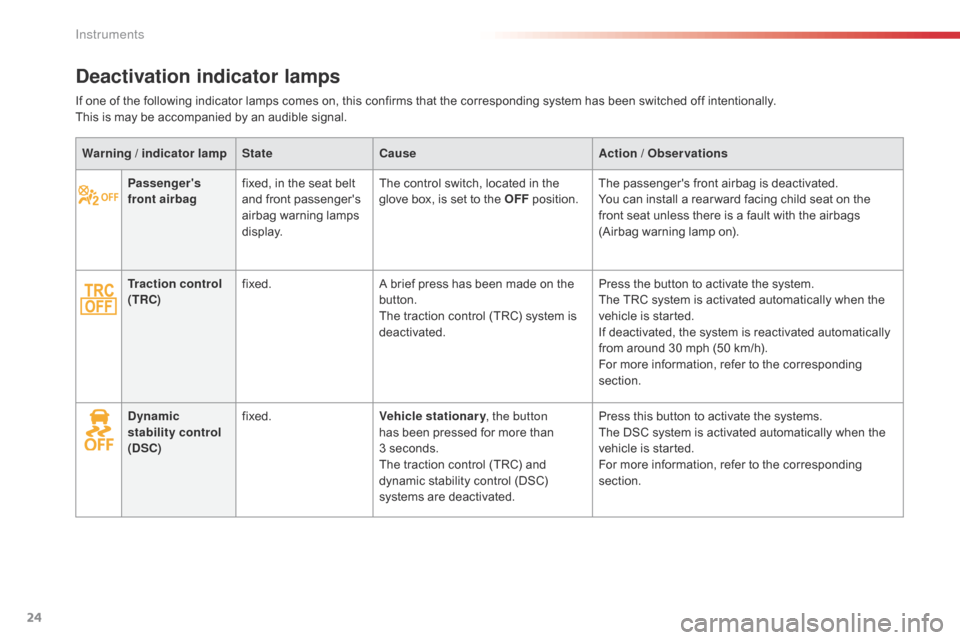
24
Passenger's
front airbagfixed,
 in  the  seat  belt  a
nd  front  passenger's Â
a
irbag
 w
arning
 lam
ps
 d
isplay. The
 control  switch,  located  in  the  g
love  box,  is  set  to  the  OFF p osition.The
 passenger's  front  airbag  is  deactivated.
You  can  install  a  rear ward  facing  child  seat  on  the Â
f
ront  seat  unless  there  is  a  fault  with  the  airbags Â
(
Airbag  warning  lamp  on).
Traction control
(TRC) fixed.
A
 brief  press  has  been  made  on  the Â
b
utton.
The
 traction  control  (TRC)  system  is Â
d
eactivated.Press
 the  button  to  activate  the  system.
The
 TRC  system  is  activated  automatically  when  the Â
v
ehicle  is  started.
If
 deactivated,  the  system  is  reactivated  automatically Â
f
rom  around  30  mph  (50  km/h).
For
 more  information,  refer  to  the  corresponding Â
s
ection.
Dynamic
stability control
(DSC) fixed.
Vehicle stationary, the button
has
 been  pressed  for  more  than Â
3Â s
econds.
The
 traction  control  (TRC)  and Â
d
ynamic  stability  control  (DSC) Â
s
ystems  are  deactivated.Press
 this  button  to  activate  the  systems.
The
 DSC  system  is  activated  automatically  when  the Â
v
ehicle  is  started.
For
 more  information,  refer  to  the  corresponding Â
s
ection.
Warning
/ indicator lamp
State Cause Action
/ Observations
Deactivation indicator lamps
If one of the following indicator lamps comes on, this confirms that the corresponding system has been switched off intentionally.
T his  is  may  be  accompanied  by  an  audible  signal.
Instruments
Page 109 of 269
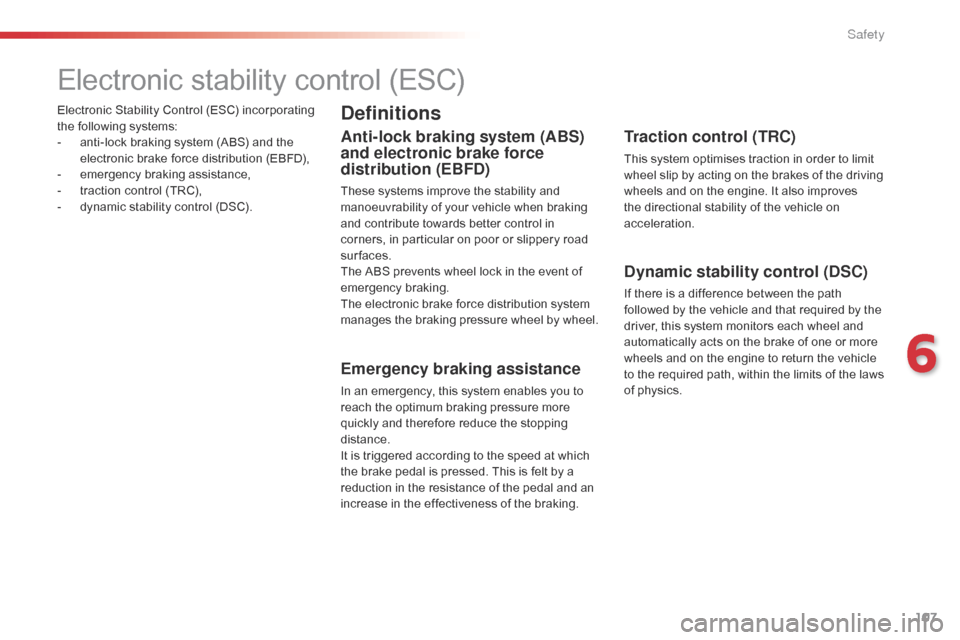
107
C1_en_Chap06_securite_ed01-2016
Electronic Stability Control (ESC) incorporating the  following  systems:
-
Â
a
nti-lock  braking  system  (ABS)  and  the Â
e
lectronic  brake  force  distribution  (EBFD),
-
 em
ergency
 b
raking
 a
ssistance,
-
Â
t
raction  control  (TRC),
-
Â
d
ynamic  stability  control  (DSC).
Electronic stability control (ESC)
Definitions
Anti-lock braking system (ABS)
and electronic brake force
distribution (EBFD)
These systems improve the stability and manoeuvrability  of  your  vehicle  when  braking Â
a
nd  contribute  towards  better  control  in Â
c
orners,  in  particular  on  poor  or  slippery  road Â
su
rfaces.
The
 ABS  prevents  wheel  lock  in  the  event  of Â
em
ergency
 b
raking.
The
 electronic  brake  force  distribution  system Â
m
anages  the  braking  pressure  wheel  by  wheel.
Emergency braking assistance
In an emergency, this system enables you to reach  the  optimum  braking  pressure  more Â
q
uickly  and  therefore  reduce  the  stopping Â
di
stance.
It
 is  triggered  according  to  the  speed  at  which Â
t
he  brake  pedal  is  pressed.  This  is  felt  by  a Â
r
eduction  in  the  resistance  of  the  pedal  and  an Â
i
ncrease  in  the  effectiveness  of  the  braking.
Traction control (TRC)
This system optimises traction in order to limit wheel  slip  by  acting  on  the  brakes  of  the  driving Â
w
heels  and  on  the  engine.  It  also  improves Â
t
he  directional  stability  of  the  vehicle  on Â
a
cceleration.
Dynamic stability control (DSC)
If there is a difference between the path followed  by  the  vehicle  and  that  required  by  the Â
d
river,  this  system  monitors  each  wheel  and Â
a
utomatically  acts  on  the  brake  of  one  or  more Â
w
heels  and  on  the  engine  to  return  the  vehicle Â
t
o  the  required  path,  within  the  limits  of  the  laws Â
o
f  physics.
6
Safety
Page 110 of 269
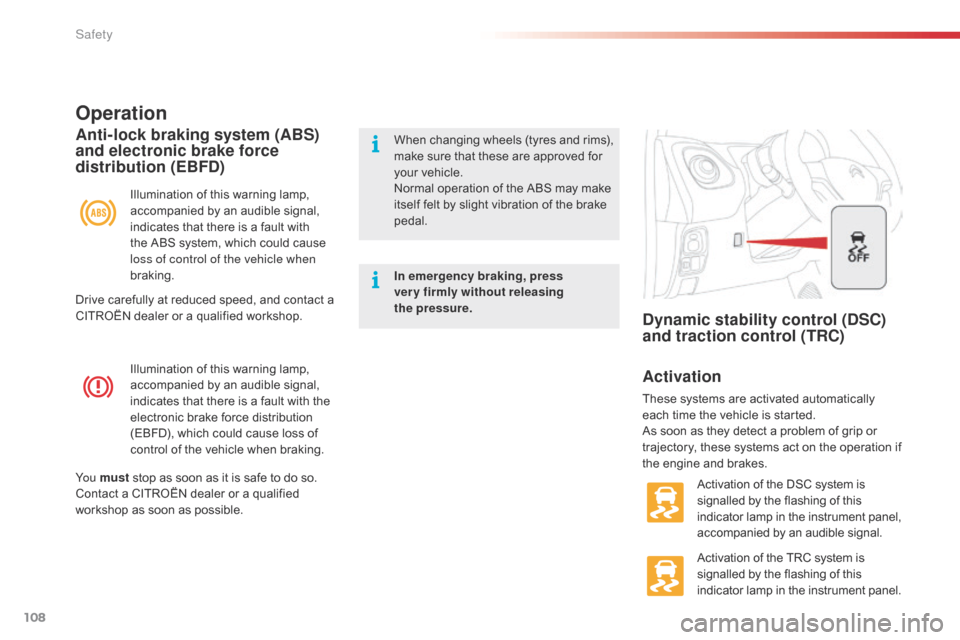
108
C1_en_Chap06_securite_ed01-2016
Illumination of this warning lamp, accompanied  by  an  audible  signal, Â
i
ndicates  that  there  is  a  fault  with  the Â
e
lectronic  brake  force  distribution Â
(
EBFD),  which  could  cause  loss  of Â
c
ontrol  of  the  vehicle  when  braking.
Operation
Illumination of this warning lamp, accompanied  by  an  audible  signal, Â
i
ndicates  that  there  is  a  fault  with Â
t
he  ABS  system,  which  could  cause Â
l
oss of control of the vehicle when
braking.
Anti-lock braking system (ABS)
and electronic brake force
distribution (EBFD)When changing  w heels  ( tyres  a nd  r ims),  m
ake  sure  that  these  are  approved  for Â
y
our  vehicle.
Normal
 operation  of  the  ABS  may  make Â
i
tself  felt  by  slight  vibration  of  the  brake Â
ped
al.
In emergency braking, press
very firmly without releasing
the
pressure.
Yo u must
Â
stop
Â
as
Â
soon
Â
as
Â
it
Â
is
Â
safe
Â
to
Â
do
Â
so.
Contact
Â
a
Â
CITROËN
Â
dealer
Â
or
Â
a
Â
qualified
Â
w
orkshop
Â
as
Â
soon
Â
as
Â
possible.
Dynamic stability control (DSC)
and traction control (TRC)
Activation
These systems are activated automatically e ach  time  the  vehicle  is  started.
As
 soon  as  they  detect  a  problem  of  grip  or Â
t
rajectory,  these  systems  act  on  the  operation  if Â
t
he  engine  and  brakes.
Activation
 of  the  DSC  system  is
 s
ignalled  by  the  flashing  of  this
 i
ndicator  lamp  in  the  instrument  panel,
 a
ccompanied  by  an  audible  signal.
Activation
 of  the  TRC  system  is
 s
ignalled  by  the  flashing  of  this
 i
ndicator  lamp  in  the  instrument  panel.
Drive
Â
carefully
Â
at
Â
reduced
Â
speed,
Â
and
Â
contact
Â
a
Â
C
ITROËN
Â
dealer
Â
or
Â
a
Â
qualified
Â
workshop.
Safety
Page 260 of 269
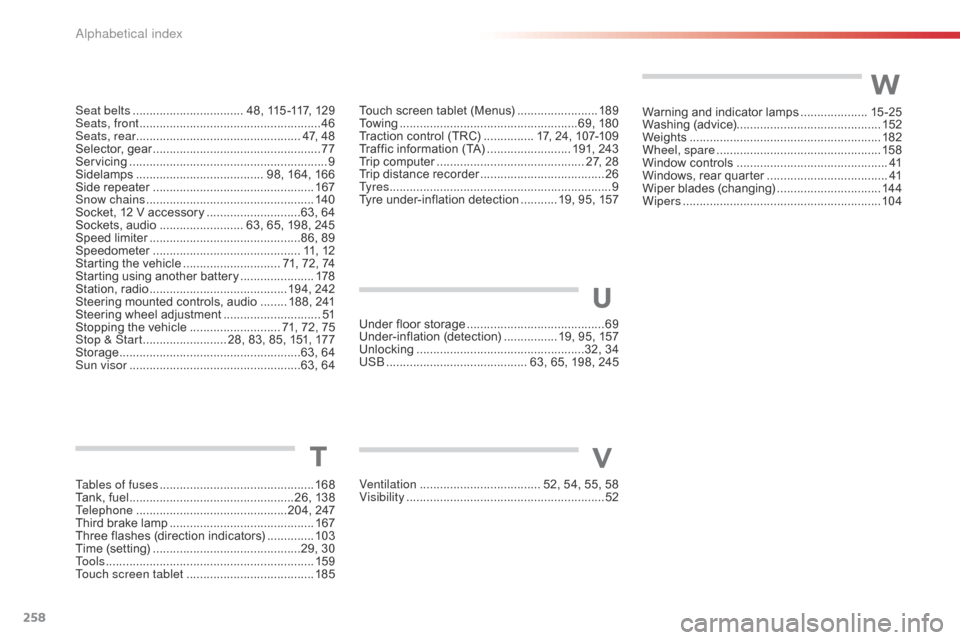
258
C1_en_Chap11_index-alpha_ed01-2016
T
Tables of fuses ..............................................16 8
Tank,  fuel  ............................... ..................26,  138
Telephone
 .............................................2
04, Â 247
Third
 brake  lamp Â
........................................... 16
7
Three
 flashes  (direction  indicators) Â
..............10
3
Time
 (setting) Â
..............................
..............29, Â 30
To o l s
 ................
.............................................. 159
Touch screen tablet
 ...................................... 18
5
Seat belts
 ................................. 4
8, Â 115 -117, Â 129
Seats, front
 ...............................
.......................
46
Seats, rear
 ................................................. 4
7, Â 48
Selector,
 ge
ar
 ..................................................
77
S
ervicing
 ...............................
............................ 9
Sidelamps
 ...................................... 9
8, Â 164, Â 166
Side
 r
epeater
 ..............................
..................
167
Snow chains
 .................................................. 14
0
Socket, Â 12 Â V Â accessory Â
............................6
3, Â 64
Sockets, Â audio Â
......................... 6
3, Â 65, Â 198, Â 245
Speed
 l
imiter
 ...............................
..............86, Â 89
Speedometer
 ..............................
..............
11,
 12
S
tarting  the  vehicle Â
............................. 7
1, Â 72, Â 74
Starting  using  another  battery Â
......................
17
8
Station,
 ra
dio
 .........................................1
94, Â 242
Steering  mounted  controls,  audio Â
........ 1
88, Â 241
Steering  wheel  adjustment Â
.............................
51
S
topping  the  vehicle Â
........................... 7
1, Â 72, Â 75
Stop & Start
 ......................... 2
8, Â 83, Â 85, Â 151, Â 177
Storage
 ................
......................................63, Â 64
Sun visor
 ...................................................6
3,  64Touch  screen  tablet  (Menus) Â
........................
18
9
To w i n g
 .....................................................6
9, Â 180
Traction  control  (TRC) Â
............... 1
7, Â 24, Â 107-109
Traffic  information  (TA) Â
......................... 1
91, Â 243
Trip  computer Â
............................................ 2
7, Â 28
Trip  distance  recorder Â
.....................................
26
T
y r e s
 ..............................................................
.... 9
Tyre  under-inflation  detection Â
........... 1
9, Â 95, Â 157
Under  floor  storage Â
.........................................
69
U
nder-inflation
 (
detection)
 ................ 1
9, Â 95, Â 157
Unlocking
 ..............................
....................32, Â 34
USB
 ........
.................................. 63, Â 65, Â 198, Â 245
U
V
W
Ventilation ..............................
...... 52, Â 54, Â 55, Â 58
Visibility ............................... ............................52Warning
 and  indicator  lamps Â
....................
15
-25
Washing
 (
advice)
........................................... 152
Weights
 ...............
..........................................
182
Wheel, spare
 ................................................. 15
8
Window  controls Â
.............................................
41
W
indows,  rear  quarter Â
....................................
41
W
iper
 b
lades
 (
changing)
 ...............................
14
4
Wipers
 ........................................................... 10
4
Alphabetical index